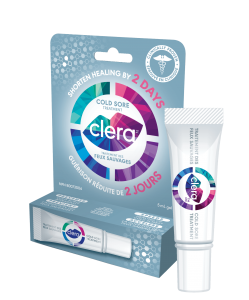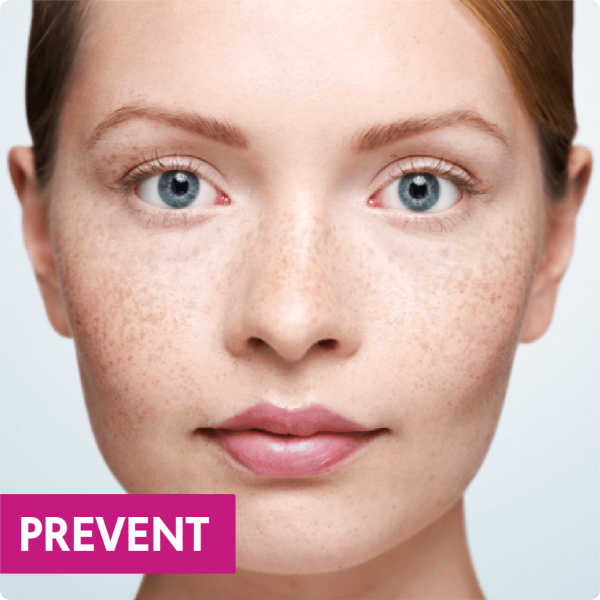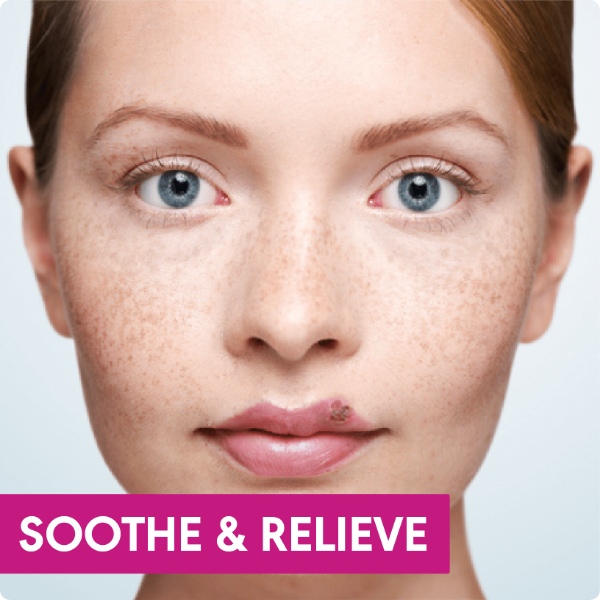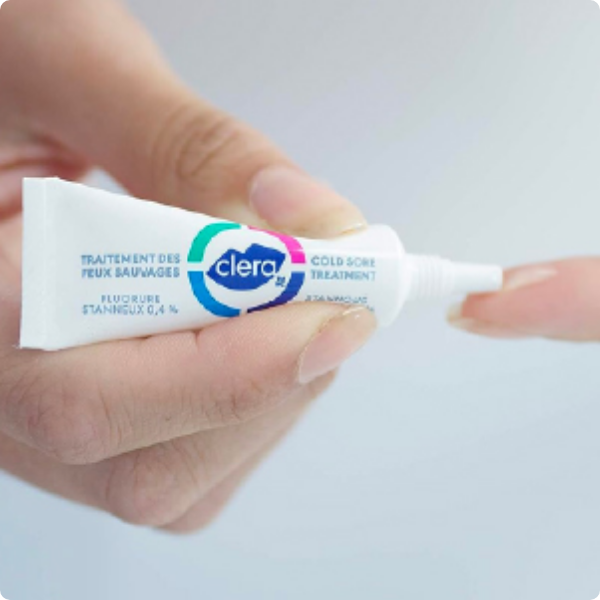Get Clear with Clera.
Cold sores are known for turning beautiful smiles into frowns. That’s where we come in. Our patented stannuous fluoride formula helps you heal faster and feel better in just 2 days*, so you can get back to smiling in no time.
*William J. Embro, DDS “Treatment Of Herpes Simplex Labialis With Stannous Fluoride Gel”, Journal of Cosmetic Dermatology” , April, 1999.


Get Clear with Clera
Cold sores are known for turning beautiful smiles into frowns. That’s where we come in. Our patented stannuous fluoride formula helps you heal faster and feel better in just 2 days*, so you can get back to smiling in no time.
*William J. Embro, DDS “Treatment Of Herpes Simplex Labialis With Stannous Fluoride Gel”, Journal of Cosmetic Dermatology” , April, 1999.
Common Cold Sore Symptoms

Common cold sores, also known as oral herpes or fever blisters, are caused by the herpes simplex virus (HSV-1). Most people experience infection in childhood or young adulthood, and the infection lasts throughout a person’s lifetime. Cold sores appear as small, fluid-filled blisters on or around the lips, though they can also develop on the nostrils, chin, or inside the mouth. They typically develop in stages, each characterized by specific symptoms.
Common Cold Sore Symptoms

Common cold sores, also known as oral herpes or fever blisters, are caused by the herpes simplex virus (HSV-1). Most people experience infection in childhood or young adulthood, and the infection lasts throughout a person’s lifetime. Cold sores appear as small, fluid-filled blisters on or around the lips, though they can also develop on the nostrils, chin, or inside the mouth. They typically develop in stages, each characterized by specific symptoms.
Cold Sore Stages
Tingling or Itching Sensation
(Prodrome Stage):
This initial stage occurs one to two days before a visible outbreak, and most individuals will experience a tingling, burning or itching sensation around the affected area, indicating an impending cold sore outbreaking. Some individuals may also experience a fever, sore throat, swollen glands or bad breath during this stage.
Blister Formation
(Vesicle Stage):
After the prodrome stage, small, red bumps begin to emerge, which soon develop into fluid-filled blisters. These blisters are usually tender and can be painful to the touch, while the skin around the blisters might become red and swollen.
Rupture and Ulceration
(Ulcer Stage):
Within a few days, the blisters break open, releasing a clear fluid that contains the active virus. This stage is often the most uncomfortable, as the open sores can be painful and may cause discomfort when eating, drinking, or talking.
Crusting and Scabbing
(Crust Stage):
As the open sores begin to heal, a crust or scab forms over them. The scab is a protective layer that shields the healing skin underneath. During this time, the cold sore may feel tight and itchy.
Healing and Resolution
(Healing Stage):
Over the next two weeks, the scab gradually falls off, revealing new skin beneath. The healing process is usually complete once the scab has disappeared, and the area may still be slightly pink for a while.
Cold Sore Stages
Phase 1
Tingling or Itching Sensation
This initial stage occurs one to two days before a visible outbreak, and most individuals will experience a tingling, burning or itching sensation around the affected area, indicating an impending cold sore outbreaking. Some individuals may also experience a fever, sore throat, swollen glands or bad breath during this stage.
Phase 2
Vesicle Stage
Blister Formation
After the prodrome stage, small, red bumps begin to emerge, which soon develop into fluid-filled blisters. These blisters are usually tender and can be painful to the touch, while the skin around the blisters might become red and swollen.
Phase 3
Ulcer Stage
Rupture and Ulceration
Within a few days, the blisters break open, releasing a clear fluid that contains the active virus. This stage is often the most uncomfortable, as the open sores can be painful and may cause discomfort when eating, drinking, or talking.
Phase 4
Crust Stage
Crusting and Scabbing
As the open sores begin to heal, a crust or scab forms over them. The scab is a protective layer that shields the healing skin underneath. During this time, the cold sore may feel tight and itchy.
Phase 5
Healing Stage
Healing and Resolution
Over the next two weeks, the scab gradually falls off, revealing new skin beneath. The healing process is usually complete once the scab has disappeared, and the area may still be slightly pink for a while.
Cold Sore Trigger Alerts
If you want to stop a cold sore when you feel it coming on, apply Clera at the first sign of a tingling sensation to prevent an outbreak.
From stress to sun exposure and weak immune systems, there are a few common factors that can trigger cold sore outbreaks. That’s why we’ve put together some practical tips to help you better protect yourself when you feel a cold sore coming on. And remember: always apply Clera at the first sign of a tingling sensation to prevent an outbreak.

STRESS
Emotional and physical stress or fatigue can wear down your immune system, and can activate the virus from within the nerve cell. To reduce your stress levels, it’s important to get enough sleep, carve out time for physical activities, eat a balanced diet and talk to a loved one about anything that might be weighing on your mind in your personal or professional life.

EXTREME WEATHER
Exposure to sunlight, sunburn, ultraviolet light sources and dryness, cold wind and chapping may trigger a cold sore. Invest in a hydrating SPF lip balm (with aloe if possible) and apply it frequently during the summer and winter months to help prevent an outbreak.

ILLNESS
Common colds and illnesses weaken your immune system and trigger cold sores, so it’s vital that you keep yourself hydrated and healthy with a balanced diet to ensure your body is getting the nutrients it needs to fend off potential outbreaks.

MENSTRUATION OR PREGNANCY
Cold sores tend to appear when a woman has her period or during pregnancy. Apply Clera to keep the cold sore from flaring up.

INJURY
Physical traumas to the sensitive areas on and around your lips, such as bites, scrapes or cuts, including forms of dental injections or tooth extractions, can also trigger cold sore outbreaks. If you injure your lip, treat the area immediately with the appropriate remedy to prevent infection.
Please note that Clera is designed for lips and face only and should not be ingested.
Benefits of Using Clera Cold Sore Treatment
Developed for over 10 years, Clera uses a revolutionary patented stannous fluoride formula that can both prevent a cold sore outbreak when applied at first tingle, and speed-up healing in as fast as 2 days*. Simply apply 1-2 drops, 2-8 times a day, and you will see results in 48 hours.

PREVENTS
Stops the herpes simplex virus (HSV-1) from spreading and prevents tissue damage from occurring.
Tip: Always have a tube on hand to act fast.

SPEEDS UP HEALING
Heals cold sores in as fast as 2 days* when applied at first tingling sensation.

RELIEVES
Apply Clera to soothe and relieve cold sore symptoms until the lesion collapses, and your immune system returns the cold sore to an inactive state.
Using Clera can result in smaller cold sore lesions and fewer recurrences of cold sores. Its use will not lead to resistant strains of the herpes virus.

REDUCES
Can result in smaller cold sores, and fewer recurrences.
* William J. Embro, DDS “Treatment Of Herpes Simplex Labialis With Stannous Fluoride Gel”, Journal of Cosmetic Dermatology” , April, 1999.
Phase 1

PREVENTS
Stops the herpes simplex virus (HSV-1) from spreading and prevents tissue damage from occurring.
 (Apply 1-2 drops, 2-8 times a day.)
(Apply 1-2 drops, 2-8 times a day.)Tip: Always have a tube on hand to act fast.
Phase 2

SPEEDS UP HEALING
Heals cold sores in as fast as 2 days* when applied at first tingling sensation.
 (Apply 1-2 drops, 2-8 times a day.)
(Apply 1-2 drops, 2-8 times a day.)* William J. Embro, DDS “Treatment Of Herpes Simplex Labialis With Stannous Fluoride Gel”, Journal of Cosmetic Dermatology” , April, 1999.
Phase 3

RELIEVES
Apply Clera to soothe and relieve cold sore symptoms until the lesion collapses, and your immune system returns the cold sore to an inactive state.

(Apply 1-2 drops, 2-8 times a day.)
Phase 4

REDUCES
Can result in smaller cold sores, and fewer recurrences.
Solutions for Maintaining Healthy Lips
Did you know that your lip health is directly connected to your lifestyle?
While various forms of stress, changes in weather and injuries to your lip area can spark a cold sore outbreak, there are several steps you can take to help keep your lips looking their best.

HYDRATION
Dehydration can affect your immune system and can cause dry mouth/chapped lips, which may trigger an outbreak. Men should drink approx. 3.7 litres of water a day and women should drink approx. 2.7 litres a day**. But it’s also important to know your body and activity levels, as your water intake could change. Getting enough fluids helps your kidneys filter waste and protects you from fatigue (a cold sore trigger).
** The National Academies of Sciences, Engineering, and Medicine..
Diet
Did you know that your lip health is linked to your diet? Eating processed foods can take a toll on your immune system, which can lead to cold sore outbreaks. Try to limit or eliminate your intake of refined sugars and processed foods, and focus on healthy greens, whole grains and consuming natural ingredients instead. Foods like beans, shrimp and chicken are high in lysine, an amino acid that has antiviral effects, which can also block arginine, another amino acid found in foods like chocolate and peanuts that has shown to increase the rate of the herpes virus. Lysine and arginine work against each other, so be mindful of what you consume to maintain smooth and healthy lips.
Skin Protection
Always wear sunscreen with a high SPF to protect yourself from harmful UV rays that can cause sunburns. Sunburns can affect your sleep and overall skin health, which can activate the herpes simplex virus. While a hydrating lip balm with SPF is an excellent way to protect your lips, it’s also important to wear sunscreen on your face and any exposed parts of your body all year round to help strengthen your immune system.
Solutions for Maintaining Healthy Lips
Did you know that your lip health is directly connected to your lifestyle?
While various forms of stress, changes in weather and injuries to your lip area can spark a cold sore outbreak, there are several steps you can take to help keep your lips looking their best.

HYDRATION
Dehydration can affect your immune system and can cause dry mouth/chapped lips, which may trigger an outbreak. Men should drink approx. 3.7 litres of water a day and women should drink approx. 2.7 litres a day**. But it’s also important to know your body and activity levels, as your water intake could change. Getting enough fluids helps your kidneys filter waste and protects you from fatigue (a cold sore trigger).
** The National Academies of Sciences, Engineering, and Medicine..
Diet
Did you know that your lip health is linked to your diet? Eating processed foods can take a toll on your immune system, which can lead to cold sore outbreaks. Try to limit or eliminate your intake of refined sugars and processed foods, and focus on healthy greens, whole grains and consuming natural ingredients instead. Foods like beans, shrimp and chicken are high in lysine, an amino acid that has antiviral effects, which can also block arginine, another amino acid found in foods like chocolate and peanuts that has shown to increase the rate of the herpes virus. Lysine and arginine work against each other, so be mindful of what you consume to maintain smooth and healthy lips.
Skin Protection
Always wear sunscreen with a high SPF to protect yourself from harmful UV rays that can cause sunburns. Sunburns can affect your sleep and overall skin health, which can activate the herpes simplex virus. While a hydrating lip balm with SPF is an excellent way to protect your lips, it’s also important to wear sunscreen on your face and any exposed parts of your body all year round to help strengthen your immune system.
